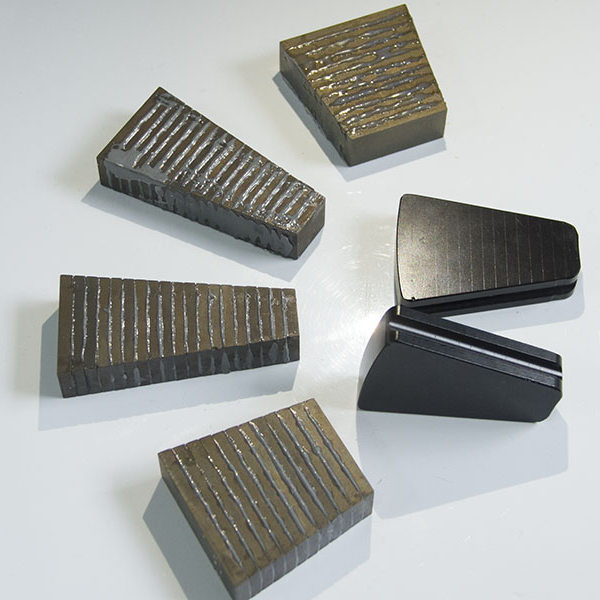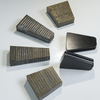Product Category
- Standard Magnets
- Customs Magnets
- Magnetic Assmblies
Laminated magnet is to cut the whole magnet into many small magnets, and then use specific glue to bond together. These small magnets are insulated from each other and can down lectromagnetic eddy current.
When the permanent magnet motor is running, the motor will generate harmonic and the magnet will generate skin effect, these all will bring a lot of eddy current loss. And then, the temperature of permanent magnet rises, which results in irreversible demagnetization and affects the safety and stability of motor operation. So the design of laminated magnet can just cut down this risk.
Due to the max working temperature of NdFeb is 220c(N35AH),more higher the temperature,the magnetic porperties of NdFeb will decrease,and the conversion rate and power of the motor will be reduced.This is called heat loss.The heat loss mainly comes from the electromagnetic eddy current in the motor work.These eddy current lossed may cause a high temperature rise,resulting in local demagnetization of permanent magnets,especially in some high speed or high frequency permanent magnet synchronous motors.Therefore,we need to reduce the heat loss by means of laminated magnets method(the insulation between small magnet piece and small magnet piece.).
Technical requirement:
1. The thinnest available insulating layers, <20 um;
2. Performance at temperatures up to 200˚C;
3. Magnet layers from .5 mm and up custom shapes and sizes in neodymium magnets.
Application scope:
Now aerospace, automotive, motorsport, and industrial markets are turning to laminated rare earth magnets, and are working to balance the tradeoff between power and heat.
Calculation of eddy current losses with and without lamination are shown below:
The eddy current simulation experiment of different piecemeal permanent magnets
Grade: N35UH Magnet
Dimension: 20x160x5mm
Experiment: Magnet are tested at different excitation frequencies in a non-piecewise and piecewise manner.
Testing Results:
1. The eddy current loss of magnet decreases with the increase of magnet segments.
2. The eddy current loss of magnet increase with the excitation frequency.
Technical requirements:
1.The thickness of insulating layers is within 0.04mm.
2. In normal temperature, the bond strength of insulating layers can reach more than 50Mpa.
3. The maximum working temperature can reach 200 ℃.
4. The whole geometric tolerance is within 0.05mm.
5. These small magnets are insulated from each other.
Feature:
1.Reducing electromagnetic eddy currrent.
2.Remaining the same magnetic properties with the whole magnet or even superior.
More Pictures
Laminated magnet is to cut the whole magnet into many small magnets, and then use specific glue to bond together. These small magnets are insulated from each other and can down lectromagnetic eddy current.
When the permanent magnet motor is running, the motor will generate harmonic and the magnet will generate skin effect, these all will bring a lot of eddy current loss. And then, the temperature of permanent magnet rises, which results in irreversible demagnetization and affects the safety and stability of motor operation. So the design of laminated magnet can just cut down this risk.
Due to the max working temperature of NdFeb is 220c(N35AH),more higher the temperature,the magnetic porperties of NdFeb will decrease,and the conversion rate and power of the motor will be reduced.This is called heat loss.The heat loss mainly comes from the electromagnetic eddy current in the motor work.These eddy current lossed may cause a high temperature rise,resulting in local demagnetization of permanent magnets,especially in some high speed or high frequency permanent magnet synchronous motors.Therefore,we need to reduce the heat loss by means of laminated magnets method(the insulation between small magnet piece and small magnet piece.).
Technical requirement:
1. The thinnest available insulating layers, <20 um;
2. Performance at temperatures up to 200˚C;
3. Magnet layers from .5 mm and up custom shapes and sizes in neodymium magnets.
Application scope:
Now aerospace, automotive, motorsport, and industrial markets are turning to laminated rare earth magnets, and are working to balance the tradeoff between power and heat.
Calculation of eddy current losses with and without lamination are shown below:
The eddy current simulation experiment of different piecemeal permanent magnets
Grade: N35UH Magnet
Dimension: 20x160x5mm
Experiment: Magnet are tested at different excitation frequencies in a non-piecewise and piecewise manner.
Testing Results:
1. The eddy current loss of magnet decreases with the increase of magnet segments.
2. The eddy current loss of magnet increase with the excitation frequency.
Technical requirements:
1.The thickness of insulating layers is within 0.04mm.
2. In normal temperature, the bond strength of insulating layers can reach more than 50Mpa.
3. The maximum working temperature can reach 200 ℃.
4. The whole geometric tolerance is within 0.05mm.
5. These small magnets are insulated from each other.
Feature:
1.Reducing electromagnetic eddy currrent.
2.Remaining the same magnetic properties with the whole magnet or even superior.
More Pictures
























